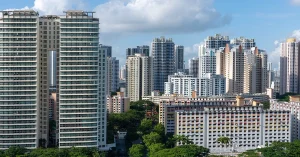GST on real estate has significantly impacted the sector since its initiation in 2017, completely transforming India’s taxation system. The real estate sector is one of those most affected, making it essential to understand the complexities of GST for properties while buying a house or investing in your dream property.
Table of Contents
In this post, we’ll talk about the impact of GST on real estate. It focuses mainly on residential and under-construction properties. Several critical concepts, such as GST rates and differences in GST between commercial and residential property, are also in the scope of this blog. Let us get started!
What is GST on Real Estate Sector?
GST is an indirect tax that is levied on the supply of goods and services. GST is applicable only to the extent of sales and purchases of property, especially as it relates to under-construction property in the real estate sector. It excludes the sales of properties already completed or of land. This difference is essential for buyers and investors because it changes the overall cost of property transactions.
GST Rates on Real Estate in India
| Particulars | GST Rate |
|---|---|
| Ready-to-Move Properties | No GST |
| Under Construction Properties (houses bought under credit linked subsidy scheme) | 8% |
| Under Construction Properties (excluding the other) | 12% |
| Resale Properties | No GST |
| Land Purchase and Sale | No GST |
| Works Contract | 18% |
| Composite Supply of Works | 18% |
| Composite Supply of Works to Govt Authority | 12% |
| Composite Supply of Works for the General Public | 12% |
| Composite Supply of Works Contract for Affordable Housing | 12% |
A Complete Overview of GST on Real Estate Sector

The Goods and Services Tax (GST) has made the taxation in the real estate sector comparatively easy to understand. It impacted under-construction properties, affordable housing, and rental income. Understanding its implications is essential for real estate players investing in properties.
1. GST for Under Construction Properties
GST for properties has changed the way the tax system works in real estate. There previously existed several more taxes, like VAT, service tax, and stamp duty, which were subsumed under GST, making a single tax with greater clarity but increasing the GST for under construction property in many cases.
As per current policies, the GST for property intended for residential use and GST for under construction property is now at 12%, with an effective rate of 1% for affordable housing. The rate includes the costs of land or an undivided share of land, as long as the costs are at least one-third of the total amount charged by the developer.
The GST rate remains unchanged whether the property is for commercial or residential use. In Haryana, stamp duty in Gurgaon for property registration vary based on factors such as the property’s location (urban or rural) and the buyer’s gender. However, tax implications can vary depending on the purpose of the property.
2. GST on Completed Properties and the Land
There is no applicability of GST on completed property or land. GST rate on residential property is also not applicable. You only need to pay registration charges and stamp duty, which may differ from state to state. This exemption decreases the overall tax burden on buyers. Now that you know this, keep it in mind before buying a property; confirm if it’s completed or under construction. This will determine whether GST is applicable or not.
3. Impact of GST on Property Prices
The market exhibited a mixed reaction once GST settled and became functional. The input tax credit (ITC) provision enables developers to claim credits for taxes paid on construction materials and services. This reduces construction costs. At the same time, it has also increased the initial cash outlay for buyers since GST rates on under-construction properties are also increased.
For example, the GST rate on residential property that is under construction would be 12 %, and someone buying an under-construction residential property might feel this claim bite deep into the overall cost. Buying an affordable housing unit is easier; however, the effective GST rate of 1% has made it more accessible for middle-income buyers.
4. Carpet Area vs Built-Up Area: How GST Affects You
Carpet area is what you can use inside the walls of a property. However, the built-up area means carpet area plus thickness of walls, spaces like balconies, terraces, etc.
The built-up area is usually taken for charging GST. This means that GST is collected on some areas that the buyer would never even get to use. So, whatever the price quoted for a property, always confirm if it is carpet or built-up. This will have a GST effect.
Also Read:- Difference Between Carpet Area and Built-Up Area
5. GST on Residential Property vs GST on Commercial Property
The GST on commercial and GST on residential property under construction is the same; however, tax implications will differ based on the intended use. Buyers acquire commercial property to use the property for business purposes, allowing them to claim input tax credit with respect to GST paid thereon. Residential properties, on the other hand, are generally purchased for personal use, making it harder for them to claim such credits.
GST on Real Estate at a Glance
Under-Construction Properties
- Residential Properties: 5% GST (No ITC)
- Commercial Properties: 12% GST (No ITC)
Ready-to-Move-in Properties
- No GST but stamp duty and registration fees apply.
Affordable Housing
- 1% GST for properties priced ≤ ₹45 lakh (No ITC)
- For a ₹40 lakh property, GST = ₹40,00,000 × 1% = ₹40,000.
Works Contracts
- 18% GST on construction/renovation services
- Example: For a ₹7 lakh contract, GST = ₹7,00,000 × 18% = ₹1,26,000
Commercial Leasing
- 18% GST on rent (if annual rent > ₹20 lakh)
- Example: Monthly rent of ₹1,50,000, GST = ₹1,50,000 × 18% = ₹27,000
Residential Properties in Gurugram
If you’re looking for affordable residential properties or luxury residential properties in Gurugram, then Ganga Realty is your answer. They believe in the purity of life and living, and this belief lies at the heart of every project, be it Tathastu born with a vision to provide housing for all, or Anantam, the tallest tower in Gurugram, a project redefining the skyline of the Millennial city. They have it all. Have your pick and enter the life of pure living!
Conclusion
The GST has changed the way properties are bought and sold in India.
GST makes tax management straightforward by eliminating all the dreaded taxes. But one really needs to look into the fine print of GST before venturing into an attempt to acquire any type of property in India, whether it is residential or otherwise commercial, ready-to-occupy or under-construction, including projects by Ganga Realty, one of the best real estate company in Gurgaon.
Frequently Asked Questions
How do rental yields in Gurgaon compare to other major Indian cities?
Gurgaon’s commercial rental yields of 6-10% per annum are among the highest in India, particularly for Grade-A office spaces. Areas like Sector 81 offer rental returns of 15.3%, while established locations like Cyber City and Golf Course Road provide stable 8-10% yields, outperforming most residential investments and traditional financial instruments.
What are the typical costs involved in buying office space in Gurgaon?
Office space costs vary by location, with premium areas like Cyber City commanding ₹150-200 per sqft monthly rental rates, while emerging sectors offer rates from ₹80-150 per sqft. Purchase prices depend on location, amenities, and project quality. Additional costs include registration fees, maintenance charges, and fit-out expenses, which should be factored into investment calculations.
Which sectors in Gurgaon offer the best investment potential for startups?
Sector 81 leads with 15.3% rental returns, followed by Sushant Lok Phase 1 (14.4%) and Sector 102 (12.3%). Established areas like Cyber City, Golf Course Road, and MG Road offer stable high returns with premium amenities. New Gurugram and Dwarka Expressway show impressive capital appreciation of 30-37% year-on-year growth.
How does buying office space compare to leasing for startups?
Buying office space provides long-term cost savings, asset building, and rental income potential from unused space. While leasing offers flexibility, purchasing eliminates rent escalations and provides tax benefits through depreciation. For startups with stable funding and growth plans, buying often proves more economical over 5-7 years.
What infrastructure advantages does Gurgaon offer for technology startups?
Gurgaon provides world-class digital infrastructure including high-speed fiber internet, reliable power supply with backup systems, advanced telecommunications, and proximity to data centers. The city offers green building certifications, energy-efficient designs, and modern co-working solutions specifically designed for technology companies and startups.
Are there financing options available for startups looking to buy office space?
Yes, several financing options exist including traditional commercial loans, developer financing schemes, lease-to-own arrangements, and partnership models. Many banks offer specialized commercial real estate loans for startups with reasonable down payments. Some developers also provide innovative financing structures that allow gradual ownership transition.
How does Gurgaon’s startup ecosystem support business growth?
With over 724 active startups and ranking 8th in India for startup activity, Gurgaon offers extensive networking opportunities, talent pool access, and potential partnerships. The city hosts major accelerators, incubators, and investors, while proximity to multinational corporations provides B2B opportunities and enterprise client access.
What are the long-term appreciation prospects for commercial real estate in Gurgaon?
Recent market data shows impressive capital appreciation rates of 30-37% in key areas like New Gurugram and Dwarka Expressway. Ongoing infrastructure projects, metro expansions, and continued corporate presence suggest sustained growth. The city’s strategic location and business-friendly policies support long-term value appreciation.
How do luxury residential projects and high-rise apartments in Gurgaon compare as investment alternatives?
While luxury residential projects in Gurgaon and high-rise apartments offer lifestyle benefits, commercial office space provides superior financial returns with 6-10% rental yields versus 3-5% for residential properties. Commercial real estate also offers better depreciation benefits, tax advantages, and appreciation potential, making it more attractive for business owners seeking both operational space and investment returns.








